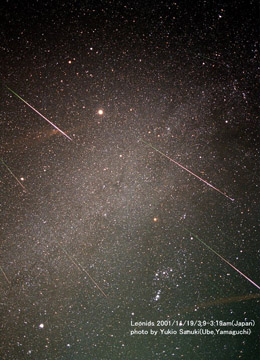Passing
comets and residual debris within the
Solar System are the source of recurrent meteor
showers. Sometimes a few pieces of debris can enter
the
atmosphere as a rogue meteor (note that the
piece of debris that burns up in the
atmosphere is a
meteor - a meteorite is the object that survives
entry and hits the ground).
The patches of debris result in recurrent meteor
showers as the
Earth orbits through the debris
cloud. Click
here
to view dates of known meteor showers, as well as
the source of the debris.
 |
This image is a good example of what a
meteor shower could look like. The camera
used was probably "piggy-backed" on a
telescope that tracks the motion of the
stars (hence the quality of the image).
During exposure, meteors trail across the
camera's field of view. This particular
image is taken of the Leonids - meaning the
center radiant of the meteors apparent
origin is from the constellation Leo. |
A meteor shower has a "radiant," meaning the
meteors appear the emanate from one general location
in the
night sky. This radiant will correspond to
the originating constellation and is named by the
origin.
One thing is certain with recurrent meteor
showers: it is difficult to predict the exact number
of meteors will be seen. For example, they
can be very dramatic this year, but sparse next
year.
The size of the meteor itself can vary from dust sized to less than the size of a marble. These "large" marble sized meteors could possible reach the Earth's surface. These large meteors can be extremely bright compared to normal meteors; these are called fireballs.
Back to Top
|

